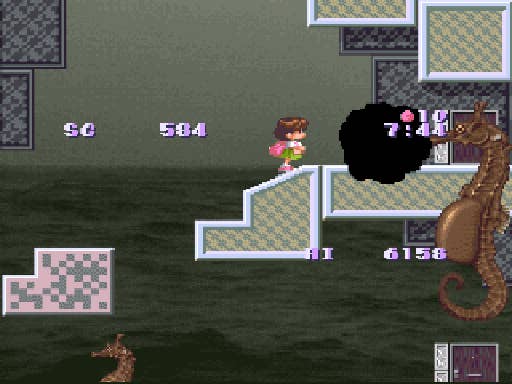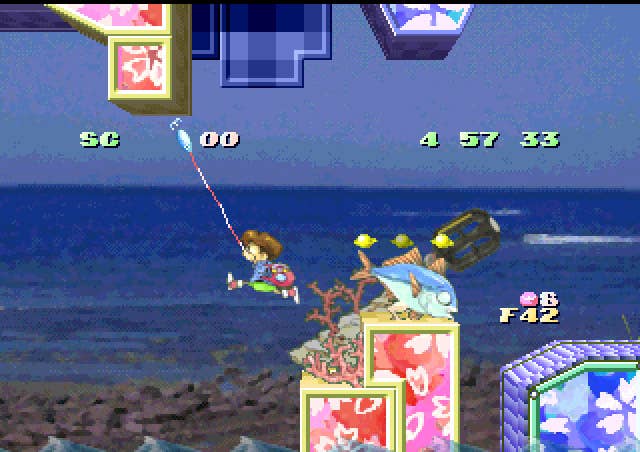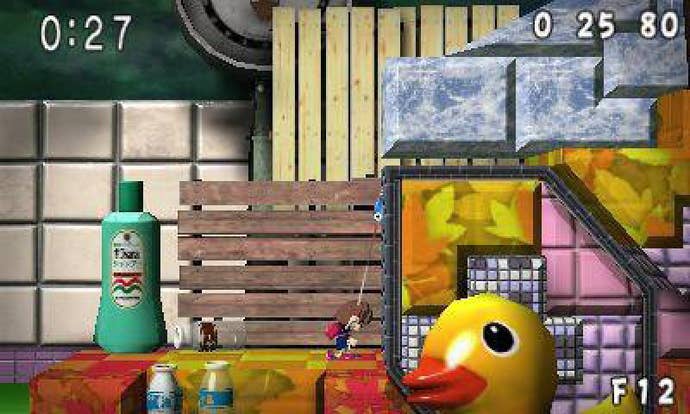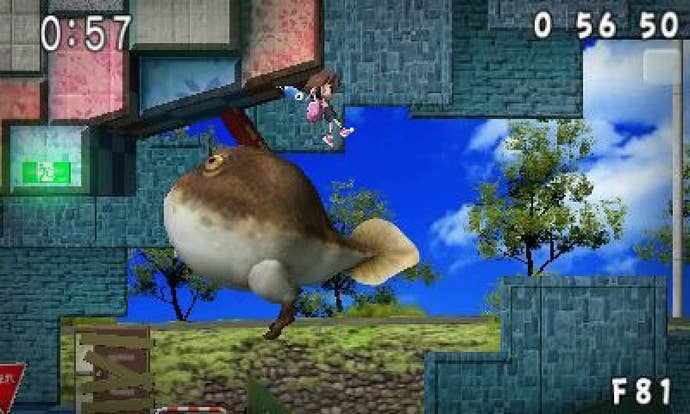Indie Before It was Cool: The Umihara Kawase Story
The creator of cult classic action game Umihara Kawase discusses the inspiration and design behind one of Japan's most legendary independent action games.
This article first appeared on USgamer, a partner publication of VG247. Some content, such as this article, has been migrated to VG247 for posterity after USgamer's closure - but it has not been edited or further vetted by the VG247 team.
The phrase "Japanese video game studio" tends to evoke certain common images: Dim, office complex-style cubicle farms; desks piled high with notes and gizmos; hard-working salarymen laboring long into the night in the cold blue light of a computer screen. Even Nintendo's so-called "fun factory" works like this.
That's only one face of the industry, however. The smaller side of the Japanese games industry -- the non-corporate, independent side of things -- isn't too terribly different from the sort of environment where you'd expect to meet independent American or Canadian game makers. The Agatsuma Entertainment office where I met with Umihara Kawase creator Kiyoshi Sakai last month, for example, is an "office" only in terms of its function. By design, it's supposed to be an apartment, tucked away in a residential area near a highway intersection off in the western fringes of Tokyo. But instead, this small studio-style home is crammed full of papers, books, software, computers, risqué Code of Princess collectibles, and a small desk offering barely enough room to conduct an interview.
Likewise, Sakai himself isn't your stereotypical vision of a Japanese game developer, either. He's neither the stoic, suit-clad worker bee of the large corporations nor the flamboyant "personality" seen among self-styled rockstar developers. His outfit consisted of slacks and a rumpled, short-sleeve oxford stained with extensive wear rather than the usual black blazer/flashy T-shirt/designer jeans uniform preferred among the more public variety of Japanese dev.
But then, Sakai's not exactly a typical designer; he's a programmer first and foremost, a vocation betrayed by his shy demeanor and thoughtful, precise manner of speaking. And his claim to fame -- cult classic platforming series Umihara Kawase -- is hardly your typical video game, either. In fact, you may never have heard of either Sakai or Umihara Kawase, since the game and its sequels have never made their way outside of Japan -- though that will be changing soon enough -- and aside from frequent mentions in Bionic Commando retrospectives and a fan-translated episode of Game Center CX (aka Retro Game Master), the series has maintained a low profile in the West.
That Bionic Commando connection is the hook that introduced me to the series in the first place; I figured anything that was so frequently mentioned alongside one of my all-time favorite games had to be worth tracking down. I wasn't disappointed, and Umihara Kawase quickly became another favorite -- though one that, unlike Bionic Commando, I've yet to complete. (It's infamously difficult, you see.) With the release of its 3DS sequel (Sayonara Umihara Kawase) I was able to track down Sakai through Sayonara's publisher, Agatsuma, and with the help of 8-4 Ltd.
Humble roots
Sakai, as it turns out, wasn't simply one of the creators of Umihara Kawase; he was the creator. For the three core games in the series -- Umihawa Kawase for Super NES, Umihara Kawase: Shun for PlayStation, and Sayonara Umihara Kawase for 3DS -- Sakai served as the singular visionary while also doing the heavy lifting.
"I was the main programmer [on the original]," he says. "I also came up with the actual game design, the concept, as well, and I’ve been directing the games.
"With Shun and also Sayonara, my involvement was the same as with the first Umihara Kawase. I did most of the programming and was the director of both games."
"I’m good at making complex game systems. I designed the game myself, and I did it in a way where I could use my ability to come up with a complex game system. I built the game design around that skill."
This isn't simply Sakai taking credit for the work of an army of dedicated minions; the original Super NES game was made by half a dozen developers, and the team behind the most recent entry was even smaller. "The team capacity kind of shrank over time," Sakai explains. "With Shun, the team size was right about the same as the Super Famicom version. However, with Sayonara, the team shrank down to almost half that size. There was only one programmer and two designers on the game."
The indie vibe of Agatsuma's offices therefore felt perfectly suited to discussing Umihara Kawase's history; the series certainly fits the definition of "independent game." Not only was Umihara Kawase the result of Sakai's personal obsession with programming, bringing it to market has always been a challenge, even from the beginning.
"In the beginning, I developed a prototype for the game," Sakai says. "Once I felt confident enough about what I had, I brought it to a friend who works at a developer. I asked him if it would be possible to make a game out of it.
"It was a little bit rough at the time. The process didn’t go very smoothly," he admits. "It took more than two years for it to come out. So it wasn’t an easy release."
New frontiers
The lack of precedent for Umihara Kawase's decidedly unique style surely didn't help. Its closest analogue is probably Bionic Commando, a game similarly focused around grappling, but the swinging mechanics there play a different role than in Sakai's project. And on top of that, Sakai was only vaguely familiar with Capcom's game.

"Top Secret -- Bionic Commando -- the arcade version had come out a couple of years before I started creating Umihara Kawase," he recalls. "I believe I learned about that game in a magazine, and I wanted to play it, but I almost never had a chance to try. I only played it once, I think. But even just playing it once, I thought it was a fun game, a good game to play.
"When you see something fun like that, it’s always a good inspiration. It’s something I would look back to. When I’m able to feel like that, I would use that kind of feeling as a reference. So perhaps in that sense, I did get some inspiration from Bionic Commando."
Ultimately, the similarities between the two titles exist on the surface. Since Umihara Kawase's heroine Yumi lacks any real offensive capabilities save for stunning and capturing fish at close range, her odyssey concerns platforming and grappling first and foremost. Where Captain Radd's bionic wire offered a means to an end in an otherwise Mega Man-like experience -- a stylish, complex replacement for the jumping most platform heroes dabble in -- Yumi's fishing hook was the whole point of the game. Umihara Kawase isn't a story but rather an arcade-style trial, a test of skill and endurance with no ultimate goal save completing the final stage.
"The games I was most inspired by weren’t wire action games [like Bionic Commando]," Sakai says, "but games like Donkey Kong and Roc'n Rope. The kind of games where you can see the whole stage in one screen, and you clear that one screen."
For science!
What really sets the game apart, however, is the extraordinary depth of its grappling physics. Unlike other grappling heroes, Yumi's fishing line offers a remarkable degree of elasticity. The term "rubbering action" is often associated with Umihara Kawase, and the despite its weird mangled-English vibe, the term fits the action quite neatly. The fishing line expands and contracts consistently and realistically as Yumi swings from platform to platform. With proper technique, you can send her careening in any number of directions from a dead stop, catapulting her up and over obstacles or simply bouncing her onto a tiny, distant piece of ground. It feels chaotic at first, but there are reliable rules behind it all, rules that can be bent to the player's will.

Umihara Kawase's platforms quickly introduce a number of special elements, like conveyor belts that you can latch onto in order to ride all the way around a floating island (even hanging from the bottom), and mastering both Yumi's wire and the strange devices that she must maneuver around requires considerable practice. But once you get the hang of it all, it becomes nearly second nature. A seasoned Umihara Kawase player can perform seemingly preposterous stunts with the greatest of ease. The math behind Yumi's swinging is so complex that the game has a tendency to slow to a crawl as the Super NES's hardware struggles to calculate the arc of her movements.
You could even argue that physics are the whole point of the game. Certainly that's where Sakai's passions would seem lie; during our interview, the one time his reserved, quiet exterior cracked to reveal a spark of bright-eyed enthusiasm came when I mentioned Umihara Kawase's complex grappling mechanics.
"First of all, I’m good at making complex game systems," he says. "I designed the game myself, and I did it in a way where I could use my ability to come up with a complex game system. I built the game design around that skill.
"When you play a game, there are the rules of the game, and if you just make it in a simple way -- press right and move right, press left and move left -- that doesn’t really take advantage of the skills players have. I wanted the player’s skill to be reflected in the gameplay. Because of that, I felt like this kind of complex game system was something that had to be in this game."
"If you just make a game in a simple way -- press right and move right, press left and move left -- that doesn’t really take advantage of the skills players have. I wanted the player’s skill to be reflected in the gameplay."
Despite the intricacy of Umihara Kawase's design, Sakai feels his work went largely unnoticed. "A group of core fans and people who were interested in programming really praised the game," he recollects with evident disappointment. "But I feel like, in general, there weren’t that many people out there who noticed the physics."
Do schoolgirls dream of electric fish?
But how did Sakai get from point A -- aspiring to make a game about physics -- to point B -- a game where a young girl swings through subtly complex, surrealistic dreamscapes patrolled by photorealistic fish marching about on human legs? He claims the pieces all simply fell into place as he went along: That Umihara Kawase is, in essence, a happy accident.
"It’s not that I had this exact idea at the beginning," he admits. "The main thing I wanted to do is create an action game that played really well. What I did is I logically thought that out -- what would make a good action game? While I was thinking through that, I decided that a wire action game would be what I wanted to create. After that, I prototyped a few games out, and Umihara Kawase was one of those prototypes. That’s the one I ended up creating as a full game."
With the core mechanics decided, the concept of using a fishing line and fighting fish-like enemies didn't leap immediately into Sakai's mind, he claims. Instead, it came together as a result of various disconnected influences over the course of development. Even the bizarre, dreamlike quality of the fish-man foes and clip art backgrounds didn't evolve from the mechanics. "The main character, Umi, is a girl, and what I wanted to express with the art style were the inner thoughts of a young girl," Sakai explains. While everything eventually came together into a thematically cohesive (albeit strange) game, Sakai's creative process was as unconventional as the game itself.

"The name 'Umihara Kawase' comes from a saying among sushi chefs in Japan," he says. "What it means is, 'With the fish in the ocean, the stomach has the best meat. With the fish in the river, their back has the best meat.' That’s where the title comes from. The reason I named the game that way, I was watching a travel program on TV, and that saying came up. It sounded really good in my ear, so that’s why I named the game that way.
"Actually, this happened right as I started creating the game. I was making game prototypes when I saw that TV show. Back then, I hadn’t decided to make a wire game or not, but I liked the sound of that. I thought that, whatever game it turned out to be, I’d give it this name.
"It wasn’t like I started out thinking, 'Oh, I’ve got to make a fishing game.' I was just thinking that maybe it might be cool if a girl’s hobby was fishing. That’s how I came up with the idea. I came up with the wire action idea first -- I didn’t come up with the fishing idea specifically so I could combine it with the wire action idea. It just sort of came together that way.
"The main reason I went with this style of game is simply that I like the wire action. I was thinking that just shooting a bullet or approaching your opponent and punching them… It’s simple action, but because it’s so simple, there’s no depth to it. It’s difficult to express depth though that kind of action. I wanted an idea that stuck out. And I happened to like the wire action, so that’s why I ended up picking this concept out of all the prototypes that I created."
A legacy
Sakai says that Umihara Kawase was his first top-to-bottom creation, though he'd worked on several fairly well-known projects prior to that. His first project was a Falcom-style PC action RPG called Euphory. Other projects he contributed to included Asmik World for Game Boy, working as lead programmer and level designer for a Mega Drive (Genesis) game based on the anime Devil Hunter Yohko, and the home port of Taito's world-spinning puzzler Cameltry.

"When I was in elementary school, there was a huge gaming boom around Space Invaders," Sakai says. "Because of that, I naturally came to think that I wanted to create a game myself. My father, because of his work, bought a PC, and I started messing around with my father’s PC and learning how to program. When I got a little older and went to junior high, I was thinking about trying to make something, and that led to programming games. That took me into creating games as a career."
Like most creators, Sakai kicked around many ideas until he landed on the concept that clicked for him. "There was one game that I created, similar to Dig-Dug 2. And then there was another one that basically… there was a maze, and then you poured water into the maze and killed the enemies with the water that you poured. I prototyped out those two games as well. When I was thinking about them just as concepts, they seemed like really awesome ideas, but once I worked out the prototypes, they didn’t turn out to be that interesting."
Umihara Kawase, on the other hand, panned out. And while it only reached a small audience, it made a lasting impression. With its intricate controls and complex branching levels -- the "true" path through the game required exploring and discovering hidden exits leading to entirely different sets of levels -- it did well enough to inspire a PlayStation sequel, Umihara Kawase Shun. That game, in turn, inspired an expansion called Umihara Kawase Shun: Second Edition. Later, Second Edition was ported to PSP and DS, and those in turn led to the creation of what may prove to be the final entry in the series, the aptly named Sayonara Umihara Kawase.
Farewell, Yumi
Interestingly, the more advanced the technology, the simpler Sakai has found the creative process. "The game system itself hasn’t changed," he says. "The specs of the hardware getting better has actually made our work easier. I didn’t feel like it was any more difficult to create these games on a higher-spec machine.
"There were a few parts of the games we changed, a few fixes to the game specs, but there weren’t any dramatic new changes or additions. I don’t feel like that made it any harder at all. The game controls haven't changed at all -- just the visual presentation. So there’s more graphical data because of that, but programming-wise it wasn’t that difficult."
"I’m not sure if there’s a future for Umihara Kawase. I don’t have any regrets about the series. I’ve done everything I wanted to do with it."
The one significant change Sayonara brings to the series (besides 3D graphics) is a somewhat easier difficulty level. Players can choose to play as several different characters with different skills, including both the younger and older versions of Yumi, her time-traveling (and time-controlling) descendant, and a friend named Emiko. Sakai says this is part of an effort to make the game accessible to more players, not just expert-level maniacs.
"The original Umihara Kawase, on Super Famicom, it was a pretty harsh, difficult game," he concedes. "Only people who were good at playing games were able to enjoy it. What I tried to do with Shun is that I wanted to make the game a little more for a wider audience. Even if you’re not that good of a game player, you’re able to play it. To do that, I made the game a little slower than how it originally was. I wanted to slow down the motion of the characters. So the framerate was originally 60, but we brought it down to 30. The game did get slower, but we intended to do that in the first place."
While those small tweaks may not be enough to launch Sayonara Umihara Kawase into mainstream success, the simple likelihood of the game reaching the U.S. will instantly give it far greater reach than any previous chapter of the series has enjoyed.
In some ways, Sakai feels the niche nature of the series has helped fuel its appeal: "Wire action is a really interesting and fun genre, but unfortunately the genre itself didn’t grow that much. There was Umihara Kawase and Bionic Commando, but there weren’t other new good games in the genre coming out. I feel like, because of that, people remember Umihara Kawase really fondly." While he'd be happy to see more people playing his game, he's also content with the legacy he's created.
"I’m not sure if there’s a future for the series," he muses. "I feel like I’d be okay either way, if it went on or if it has to end here. I don’t have any regrets about the series. I’ve done everything I wanted to do with it. At this point, I don’t feel like, 'Oh, I have to make another game to accomplish this or that.'"
Even if Sakai really does bid sayonara to Umihara Kawase with this latest chapter of the series, it would wholly fitting if this were indeed the one entry to finally venture beyond Japan. Despite the games' quirky visual style, its intense challenge and the fundamental spirit of personal, independent passion behind its creation seem likely to find a sympathetic audience in the West.
"Here in Japan, there’s a trend -- or I guess it’s the opposite of a trend -- but action games aren’t that popular nowadays, especially these kinds of technical action games," Sakai laments. "Games where you have to practice really hard to become a good player... they aren’t very popular here anymore. But Umihara Kawase is that kind of game, so I hope that people outside of Japan, overseas, will enjoy this game enough to practice and excel at it."


